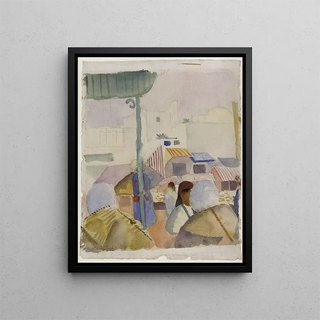Art print | Tunis Market II - August Macke


View from behind

Frame (optional)
In the fascinating world of modern art, "Marché de Tunis II" by August Macke stands out for its vibrancy and expressiveness. This artwork, created in 1914, immerses the viewer in a lively world of colors and light, where Tunisian culture is celebrated. Macke, a prominent member of the expressionist movement, manages to capture the very essence of the Tunisian market, a place of meeting and exchange, while infusing it with an almost dreamlike dimension. By admiring this art print, one is immediately transported into the hustle and bustle of a lively market, where spicy aromas and shimmering colors seem to come alive.
Style and uniqueness of the artwork
August Macke's style is characterized by bold use of colors and an innovative approach to composition. In "Marché de Tunis II," vivid hues dominate, creating a warm and welcoming atmosphere. The human figures, though stylized, exude a palpable presence, reflecting the importance of social interactions within this setting. The forms are simplified, almost geometric, but they retain a certain fluidity that evokes movement and life. Shadows and lights play a crucial role, emphasizing the scene's dynamism. This art print is a perfect example of how Macke succeeds in blending reality and abstraction, offering the viewer a rich and immersive visual experience. The composition is carefully orchestrated, with each element finding its place to form a harmonious whole, guiding the eye through a captivating visual narrative.
The artist and his influence
August Macke, born in 1887 in Meschede, Germany, is one of the most influential artists of the early 20th century. His encounter with Fauvism and Expressionism profoundly marked his work, allowing him to explore various themes while developing an inimitable personal style. Macke traveled across Europe and North Africa, immersing himself in the cultures he encountered and translating these influences into his painting. His stay in Tunis in 1914 was decisive, not only for his art, but also for his

Matte finish

View from behind

Frame (optional)
In the fascinating world of modern art, "Marché de Tunis II" by August Macke stands out for its vibrancy and expressiveness. This artwork, created in 1914, immerses the viewer in a lively world of colors and light, where Tunisian culture is celebrated. Macke, a prominent member of the expressionist movement, manages to capture the very essence of the Tunisian market, a place of meeting and exchange, while infusing it with an almost dreamlike dimension. By admiring this art print, one is immediately transported into the hustle and bustle of a lively market, where spicy aromas and shimmering colors seem to come alive.
Style and uniqueness of the artwork
August Macke's style is characterized by bold use of colors and an innovative approach to composition. In "Marché de Tunis II," vivid hues dominate, creating a warm and welcoming atmosphere. The human figures, though stylized, exude a palpable presence, reflecting the importance of social interactions within this setting. The forms are simplified, almost geometric, but they retain a certain fluidity that evokes movement and life. Shadows and lights play a crucial role, emphasizing the scene's dynamism. This art print is a perfect example of how Macke succeeds in blending reality and abstraction, offering the viewer a rich and immersive visual experience. The composition is carefully orchestrated, with each element finding its place to form a harmonious whole, guiding the eye through a captivating visual narrative.
The artist and his influence
August Macke, born in 1887 in Meschede, Germany, is one of the most influential artists of the early 20th century. His encounter with Fauvism and Expressionism profoundly marked his work, allowing him to explore various themes while developing an inimitable personal style. Macke traveled across Europe and North Africa, immersing himself in the cultures he encountered and translating these influences into his painting. His stay in Tunis in 1914 was decisive, not only for his art, but also for his






